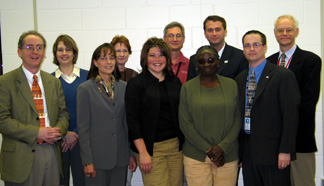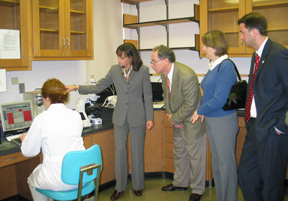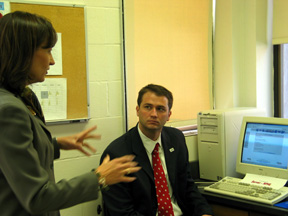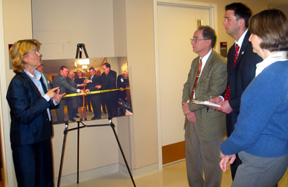 |
Visitors posed for a group photo, along with UNMC and UNO staff. From left are: Rex Astles, Ph.D., and Joyce Witt, Centers for Disease Control and Prevention; Ann Fruhling, Ph.D., UNO; Rhonda Noel, UNMC; Michelle Lund, UNO; Tony Sambol, UNMC; Jumoke Omojola, UNO; Jim Ford, Association of Public Health Laboratories; Josh Rowland, UNMC; and Steven Hinrichs, M.D., UNMC. |
Not only did they see how grants received by the Nebraska Public Health Laboratory (NPHL) at UNMC were being put to work, they toured the Biocontainment Unit on campus and attended an April 21 talk UNMC officials gave during a bioterrorism symposium in Norfolk.
 |
Ann Fruhling, Ph.D., University of Nebraska at Omaha, second from left, and Rhonda Noel, far left, demonstrate called STATPack. Visitors from left are Rex Astles, Ph.D., and Joyce Witt, Centers for Disease Control and Prevention and Jim Ford, Association of Public Health Laboratories. |
The STATPack provides a secure, patient privacy-compliant, Internet-based network for selected hospital labs across Nebraska to communicate routine, urgent and emergency messages. Designed to support clinical laboratories in Nebraska during public health emergencies, the system enables labs to capture and send microscopic or photographic images of suspicious organisms for immediate consultation and possible identification.
Initial funding for the STATPack came from the Nebraska Research Initiative (tobacco settlement). The network is employed in Scottsbluff, North Platte, Kearney, Norfolk, Grand Island, Offutt Air Force Base in Bellevue and the NPHL. Most recently, through funding received from the CDC and APHL, units have been placed in the University of Nebraska-Lincoln Veterinary Science Diagnostic Laboratory, the Nebraska Health and Human Services (NHHSS) System Water Testing Laboratory and the Nebraska Department of Agriculture Food Testing Laboratory, forming a cohesive laboratory network.
 |
Ann Fruhling, Ph.D., left, University of Nebraska at Omaha, tells Jim Ford of the Association of Public Health Laboratories about STATPack. |
The visitors were impressed by what they saw.
In referring to the STATPack, Astles said he hadn’t seen such a system before. “This will be much quicker than mailing specimens in routine or emergency situations,” he said.
In the past, CDC officials, including Astles, have noted Nebraska’s success in laboratory operations following Sept. 11, 2001. Sambol said work done in Nebraska provided a model of testing for anthrax and other potential deadly pathogens and also helped establish critical benchmarks on how state public health laboratories should interact with private hospitals to build a national laboratory network.
During a luncheon hosted by the lab, NPHL Director Steven Hinrichs, M.D., shared feedback made about Nebraska by CDC Director Julie Gerberding, M.D., during testimony on Capitol Hill.
 |
Pat Lenaghan, left, nurse coordinator of the Biocontainment Unit, tells visitors about the unit. Visitors from left are: Rex Astles, Ph.D., CDC senior health scientist; Jim Ford, laboratory systems/standards manager, Association of Public Health Laboratories, and Joyce Witt, health scientist, CDC. |